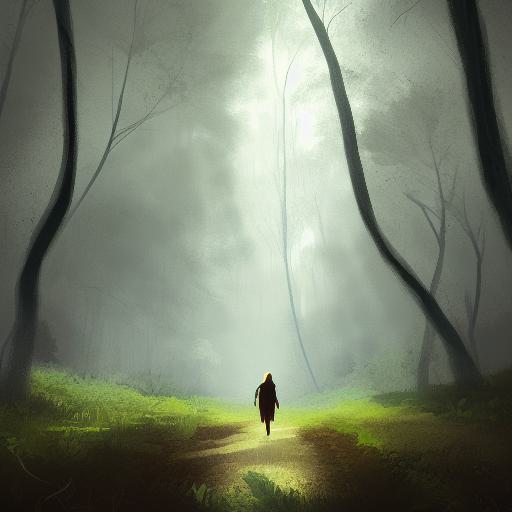How to write this prompt?
To write an AI prompt like the one provided, you need to consider the following aspects:
- Subject matter: The prompt begins by describing the subject matter of the image as “a person walking through a forest.” This provides a clear idea of what the image will depict and helps the AI generate an appropriate scene.
- Mood and atmosphere: The prompt further describes the image as “melancholic,” suggesting a sad or reflective mood. The use of the word “Spring” also implies a sense of new beginnings and growth. These details provide additional context for the AI to create an appropriate atmosphere in the image.
- Artistic style: The prompt mentions that the image is a “digital painting” and describes the artist as a “contest winner.” This provides information about the expected style and quality of the image.
- Conceptual design: The prompt describes the image as “conceptual art” and “environment design illustration,” indicating that the image should be more than just a realistic representation of a forest scene. The AI should incorporate elements that reflect the theme or message of the artwork.
All of these individual parts work together to influence the final image generated by the AI. The subject matter provides the basic framework for the image, while the mood and atmosphere create an emotional tone. The artistic style and conceptual design help guide the details and composition of the image. By combining all of these elements, the prompt helps the AI generate an image that meets the expectations and intentions of the creator.
Who is Sparth?
Sparth, whose real name is Nicolas Bouvier, is a French concept artist and illustrator who is known for his visually stunning and imaginative landscapes and environments. He has worked on a wide range of projects, including video games, books, and films, and has developed a distinctive style that blends organic and mechanical elements to create a sense of otherworldly beauty and wonder.
Sparth is highly regarded in the concept art and illustration communities, and his work has been featured in numerous exhibitions and publications. He is also an accomplished author and has published several books on art and design.
What are the keywords for generating Spring landscape?
Some keywords that could be used to generate a Spring landscape using AI art generation prompts include:
- Flowers
- Blossoms
- Trees
- Greenery
- Sunshine
- Blue skies
- Birds
- Butterflies
- Streams
- Waterfalls
These keywords could be used to generate a wide range of Spring landscapes, from pastoral scenes with rolling hills and fields of flowers to more dramatic landscapes with waterfalls and rocky cliffs.
What is Artstation?
Artstation is an online platform that is dedicated to the art and design community. It provides a space for artists and creatives to showcase their work, connect with other artists, and find job opportunities and professional development resources.
Artstation features a wide range of art and design categories, including digital painting, concept art, 3D modeling, and animation. It also offers tools and resources for artists, such as tutorials, courses, and job listings.
Artstation is a popular platform for artists and creatives of all levels, from students and hobbyists to seasoned professionals. It is a valuable resource for anyone looking to connect with other artists, share their work, and explore new opportunities in the art and design industry.
Can I sell AI-generated art?
Yes, you can sell AI-generated art, but there are some important considerations to keep in mind. Because AI-generated art is created using algorithms and machine learning techniques, it may be subject to copyright and intellectual property laws.
It’s important to ensure that you have the legal right to use any source material or data that the AI algorithms are based on, and that you are not infringing on the rights of other artists or creators.
Additionally, it’s important to be transparent about the fact that your art is generated using AI, and to be clear about the role that you played in the creation process. Some buyers may be interested in the novelty of AI-generated art, while others may prefer more traditional forms of art.
What types of art can be generated using AI?
AI can be used to generate a wide variety of art, including:
- Images and graphics, including abstract designs, landscapes, and portraits.
- Music and sound, including compositions and sound effects.
- Video and animation, including short films and animated sequences.
- Text and language, including poetry and prose.
- Interactive experiences, including games, chatbots, and virtual reality simulations.
AI-generated art can be created using a variety of techniques, including machine learning algorithms, neural networks, and generative adversarial networks (GANs). These techniques allow AI to analyze and learn from existing art, and then generate new works of art that are similar in style, composition, and content. AI-generated art can be used for a wide range of applications, from commercial advertising and marketing to fine art and creative expression.
Visualize your ideas like never before with the power of AI-generated art and design tools from Visual Paradigm Online. Elevate your designs to the next level by effortlessly integrating stunning graphics with just a few clicks. With a user-friendly interface and a vast selection of design templates and assets at your disposal, you can explore and experiment with various styles and layouts until you create the perfect masterpiece. Discover the limitless potential of AI-generated art and transform your creative vision into reality with Visual Paradigm Online.


